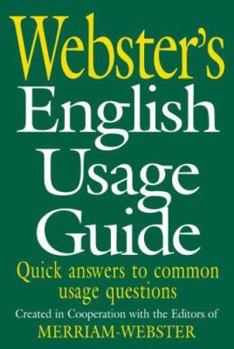Merriam-Webster's Dictionary of English Usage
Select Format
Select Condition 
Book Overview
Customer Reviews
Rated 5 starsScholarly research, authoritative yet cautious discussion, and vast bredth and depth.
Peruse the bookstore sections on Grammar and Usage, and you'll see there has never been a lack of experts who want to tell you how to write. But the problem with just about every one of these books is that their explanations of grammatical phenomenona are misleading: they're not researched at all. In fact, they're not so much based on English as real writers actually use it, so much as they're based on how the writer fancies...
1Report
Rated 5 starsFor anyone who works with words
Merriam-Webster's Concise Dictionary Of English Usage: The Essentials Of Clear Expression is a well organized, extremely practical, "user friendly" writer's reference. More than 2,000 extensive and meticulous entries discuss the nuances in the daily uses, both historical and present, of commonly confused words in the English language. Enhanced with a multi-page bibliography, Merriam-Webster's Concise Dictionary Of English...
0Report
Rated 5 starsBy far the best usage manual available
The readers' reviews for this book tend toward the extremes. Readers are not ambivalent about this book. I am no different. I rarely give five stars, but this is simply the best usage manual available (and I have the major ones and many of the minor ones).Here is the format for a typical entry: There is a statement of the question; a survey of the opinions of previous usage writers; a survey of actual usage from early times...
0Report
Rated 5 starsA Book for the Curious and not for the Ignorant
In one of the earlier reviews of this book the entry for "at" was misrepresented. I thought I would take some time to set the record straight. The entry for "at" is on page 141. It notes that usage writers from Vizetelly in 1906 onward have written disapprovingly about the use of the preposition "at" somewhere in the vicinity of and especially after the adverb where. The entry goes on to say that this is evidently...
0Report
Rated 5 starsInformative and entertaining
If you want a useful, well-researched guide to the way English is actually used by real creative writers, past and present, buy this book. If you want to be entertained while reading about English grammar (not easily done!), buy this book. If you prefer to blindly follow rigid rules which, rather than reflecting the way the language is actually used, reflect the way some 18th or 19th century usage writers thought it...
0Report














